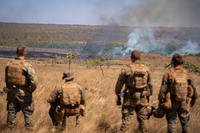Doritha E. Douglas, or Decie, as she is known to her friends, was a small town girl from Williamstown, Penn., and a coal miner’s daughter. Her early life revolved around her family and friends in a close community life. She pursued her education and after receiving a bachelor’s degree from West Chester State Teachers College, Douglas became a high school English teacher back in her hometown. Her plans were to continue in the field of education.
However, December 1941 changed those plans, not only for her, but for people all around the world. U.S. involvement in World War II grew rapidly and in November 1942 Douglas and her friend Bobbe Keiter, another teacher, decided they should take a leave of absence from teaching and join the military. They wanted to help in the war effort and going from a stable environment into the unknown sounded exciting!
Philadelphia was located 90 miles away, but was the closest place to enlist. Both of the young women were cleared to join the Navy WAVES officer program. Then, about two weeks later and before entering the Navy, they learned of a new opportunity. In the news, President Roosevelt had just signed legislation creating a women’s reserve in the Coast Guard.
“We thought we’d have a better chance to advance in rank and benefits,” said Wolf.
So, back to Philadelphia they went. Both were accepted and sworn into the Coast Guard Reserve as midshipmen. No one knew when the war would end and more men where needed for combat. Trained, educated women could easily replace men in clerical positions and work alongside men, but they just couldn’t tell them what to do.
The next phase of their Coast Guard career consisted of six weeks of training and testing. The first three weeks were spent at the Naval Training Station at Smith College in Northhampton, Mass. This was the same school Dorothy Stratton – the first woman to be accepted for service in the Women’s Reserve – had attended in 1942 and where the first 200 women’s reserve officers trained. Douglas’ class of 29 passed the training and were sent directly to the Coast Guard Academy in New London, Conn., where they would spend the next three weeks training before graduating as officers.
The Coast Guard Academy is an institution steeped in tradition. The infusion of the first 29 female recruits in its history presented many with opportunity to change their minds and attitudes about their new shipmates.
“The men didn’t like it or want to accept us being there,” said Douglas. “They gave us a floor of our own in the men’s dorm and it was off limits to them.”
There was a lot to learn and learn fast. It was a tough three weeks of bias and mental stress on top of a hike each morning. But they got through it. All 29 midshipmen graduated and were commissioned. Douglas earned her blue braid to adorn her fitted dress blues and became Ensign Doritha Douglas, SPAR. After graduation, she had to say goodbye to her friend. Douglas was assigned to St. Augustine, Fla., and Keiter to Washington D.C. They wrote, but never saw each other again.
“I really liked St. Augustine,” said Decie. “I met my husband there. He was a handsome man, Lt. John Douglas from Texas. He was passing through before heading off to the Pacific where he ran supply convoys, including explosives. And he was [commanding officer] of his own ship. We met in January 1944, and got married in March, pretty quick, before he had to ship off.”
After her service ended in St. Augustine, she was a civilian again. She moved in with her husband’s family in Houston, until his return in late 1945. Then, their life together really started and it lasted 66 years. They had lots of Coast Guard friends in the Houston area with whom they often spent time with and for many years they’d go to dinner and dancing at Ellington Air Field.
Her husband passed two years ago and was buried at sea by the Coast Guard in Galveston, Texas.
Although Douglas never met her, she spoke highly of Dorothy Stratton and was happy to hear that a new cutter now carried her name forward.
“I would have liked to have gone on some other types of duty, maybe to sea,” said Wolf.
Reflecting on her role as a trailblazer, she states she is glad there are more women in the Coast Guard now, with more choices. In fact, there are currently more than 3,000 active duty women in the Coast Guard.
All in all, Douglas has some great memories from a time so many years ago. To her, it’s just a small part of her life.
“I don’t really understand why anyone wants to hear about any of this anyway,” she says. But Douglas’ story – and that of the more than 11,000 women who served as SPARs – has woven the fabric of our service today. We don’t want to hear their stories; we need to hear their stories.






















